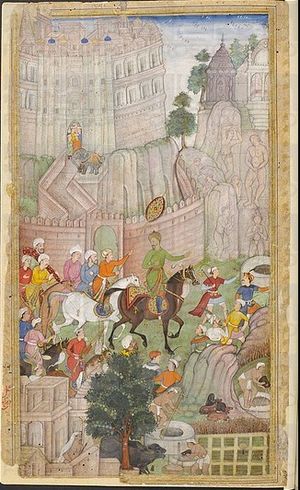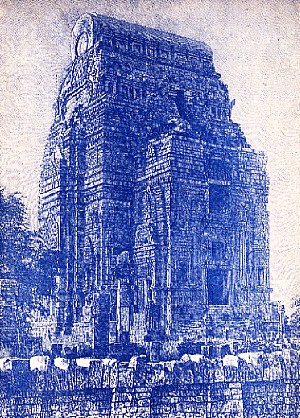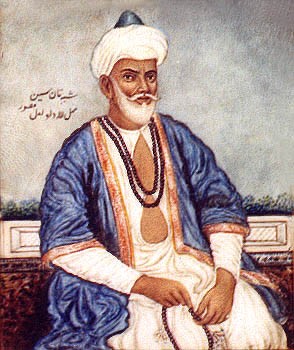گواليأور
گواليأور
ग्वालियर Gwalior | |
|---|---|
 مع عقارب الساعة من اليسار: حصن گواليأور، قصر جاي ڤيلاس، المحكمة العليا ومعبد الشمس | |
| الكنية: العاصمة السياحية لماديا پرادش مدينة راجا سورسن مدينة ريشي گلڤ و تانسن نگري | |
| الإحداثيات: 26°13′17″N 78°10′41″E / 26.221521°N 78.178024°E | |
| البلد | الهند |
| الولاية | ماديا پرادش (MP) |
| المنطقة | Gird |
| District | گواليأور |
| أسسها | راجا سوراج سن |
| السمِيْ | Saint Gwalipa |
| المساحة | |
| • الإجمالي | 780 كم² (300 ميل²) |
| ترتيب المساحة | 35th |
| المنسوب | 196 m (643 ft) |
| التعداد (2011) | 1٬901٬981 |
| • الكثافة | 5٬478/km2 (14٬190/sq mi) |
| • ترتيب التعداد | 31st |
| اللغات | |
| • الرسمية | هندي والإنگليزية |
| منطقة التوقيت | UTC+5:30 (IST) |
| PIN | 474001 to 474055 (HPO) |
| Telephone code | 0751 |
| لوحة السيارة | MP-07 |
| نسبة الجنسين | .948 ♂/♀0 |
| معرفة القراءة | 87.20%[1] |
| متوسط درجة حرارة الصيف | 41 °C (106 °F) |
| متوسط درجة حرارة الشتاء | 10.1 °C (50.2 °F)[contradiction] |
| الموقع الإلكتروني | [1]/Gwalior Official Website |
گواليأور (Gwalior ؛ النطق ) is a historic and major city in the Indian state of Madhya Pradesh and one of the Counter-magnet cities. Located 319 kilometres (198 mi) south of Delhi the capital city of India, Gwalior occupies a strategic location in the Gird region of India. The city and its fortress have been ruled by several historic northern Indian kingdoms. From the Tomars in the 13th century, it was passed on to the Mughals, then to the Marathas in 1754 followed by the Scindias in 18th century.[2]
أصل الاسم
According to local tradition, Gwalior owes its name to a sage of former times. سوراج سن، a prince of the gurjar-pratihar clan of the eighth century, is said to have lost his way in the forest. On a secluded hill, he met an old man, the sage Gwalipa, whose influence almost took him by surprise. Upon asking the sage for some drinking water, he was led to a pond, where the waters not only quenched his thirst but cured him of leprosy.[2] Out of gratitude, the prince wished to offer the sage something in return, and the sage asked him to build a wall on the hill to protect the other sages from wild animals which often disturbed their yajnas (or pujas). Suraj Sen later built a palace inside the fort, which was named "Gwalior" after the sage, and eventually the city that grew around the fort took the same name.
التاريخ
ثورة 1857
ويُعرف عن گواليأور عدم مشاركتها في ثورة 1857، أساساً لعدم التعاون مع راني لاكشميباي. After Kalpi (Jhansi) fell into the hands of the British on 24 May 1858, Lakshmibai sought shelter at Gwalior Fort. The Maharaja of Gwalior was not willing to give up his fort without a fight as he was a strong ally of the British, but after negotiations, his troops capitulated and the rebels took possession of the fort. The British wasted no time in attacking Gercest, the battle was fought by Lakshmibai, the bloodiest battle ever fought on Indian soil.[3] Indian forces numbered around 20,000, and British forces around 1600 assisted by Maharaja of Gwalior troops. Lakshmibai's example is remembered to this day by Indian nationalists. She died fighting, and Gwalior was free from rebels. Tatya Tope and Rao Sahib escaped.[4] Tatya Tope was later captured and hanged in April 1859.
إمارة گواليأور
Scindia هي Maratha clan in India. This clan included rulers of the إمارة گواليأور في the 18th and 19th centuries, collaborators of the colonial British government during the 19th and the 20th centuries until India became independent, and politicians in independent India.
- 1727–1745 : Rânojî Râo Sindhia (+1745)
- 1745–1755 : Jayapaji Râo Sindhia (v. 1720–1755)
- 1755–1761 : Jankojî Râo Ier Sindhia (+1761)
- 1761–1764 : Kandarji Râo Sindhia (+ap.1764)
- 1764–1768 : Manaji Rao Sindhia
- 1768–1794 : Mahadji Rao Sindhia (1729–1794), Radjah de Gohad en 1765 puis Maharadjah de Gwalior
- 1794–1827 : Daulat Râo Sindhia (1779–1827)
- 1827–1843 : Jânkojî Râo II Sindhia (Mukki Râo) (1805–1843)
- 1843–1886 : Jayâjî Râo Sindhia (Jiajî Râo) (1835–1886)
- 1843–1844 : Dada Khasjiwallah - en rébellion
- 1886–1925 : Mâdhav Râo Sindhia (1876–1925)
- 1925–1961 : George Jîvâjî Râo Sindhia (1916–1961)
- 1961-2001 : Madhav Rao II Scindia (1945-2001)
- 2001-.... : Jyotiraditya Rao Scindia (1971–Present) (Present Maharaja of Gwalior)
الديانة
المناخ
| Gwalior | ||||||||||||||||||||||||||||||||||||||||||||||||||||||||||||
|---|---|---|---|---|---|---|---|---|---|---|---|---|---|---|---|---|---|---|---|---|---|---|---|---|---|---|---|---|---|---|---|---|---|---|---|---|---|---|---|---|---|---|---|---|---|---|---|---|---|---|---|---|---|---|---|---|---|---|---|---|
| جدول طقس (التفسير) | ||||||||||||||||||||||||||||||||||||||||||||||||||||||||||||
| ||||||||||||||||||||||||||||||||||||||||||||||||||||||||||||
| ||||||||||||||||||||||||||||||||||||||||||||||||||||||||||||
Gwalior has a sub-tropical climate with hot summers from late March to early July, the humid monsoon season from late June to early October, and a cool dry winter from early November to late February. Under Köppen's climate classification the city has a humid subtropical climate. The highest recorded temperature was 48 °C and the lowest was −1 °C. Summers start in late March, and along with other cities like Jaipur and Delhi, are among the hottest in India and the world. Temperatures peak in May and June with daily averages being around 33–35 °C (93–95 °F), and end in late June with the onset of the monsoon. Gwalior receives 900 mm (35 in) of rain on average per year, most of which is concentrated in the monsoon months from late June to early October. August is the wettest month with about 310 mm (12 in) of rain. Winter in Gwalior starts in late October, and is generally very mild with daily temperatures averaging in the 14–16 °C (58–62 °F) range, and mostly dry and sunny conditions. January is the coldest month with average lows in the 0 °C range (32 °F) and occasional cold snaps that plummet temperatures to close to freezing.
| Climate data for گواليأور | |||||||||||||
|---|---|---|---|---|---|---|---|---|---|---|---|---|---|
| Month | Jan | Feb | Mar | Apr | May | Jun | Jul | Aug | Sep | Oct | Nov | Dec | Year |
| Mean daily maximum °C (°F) | 22.9 (73.2) |
26.5 (79.7) |
32.7 (90.9) |
38.7 (101.7) |
42.1 (107.8) |
48.6 (119.5) |
40.5 (104.9) |
32.0 (89.6) |
32.7 (90.9) |
33.2 (91.8) |
29.3 (84.7) |
24.4 (75.9) |
32.5 (90.5) |
| Mean daily minimum °C (°F) | 0.1 (32.2) |
10.0 (50.0) |
15.8 (60.4) |
22.2 (72.0) |
27.2 (81.0) |
29.5 (85.1) |
26.6 (79.9) |
25.3 (77.5) |
23.9 (75.0) |
18.4 (65.1) |
11.5 (52.7) |
7.4 (45.3) |
18.7 (65.7) |
| Average precipitation mm (inches) | 16.5 (0.65) |
8.0 (0.31) |
7.0 (0.28) |
2.6 (0.10) |
8.9 (0.35) |
78.7 (3.10) |
261.6 (10.30) |
312.9 (12.32) |
146.2 (5.76) |
42.6 (1.68) |
4.2 (0.17) |
7.7 (0.30) |
900.0 (35.43) |
| Source: IMD | |||||||||||||
Tourism
حصن گواليأور

جاي ڤيلاس محل
القلعة الپنجابية، لاس گواليأور
معبد الشمس في گواليأور
أشهر أبنائها
- Amjad Ali Khan; sarod player and musician
- Atal Bihari Vajpayee; former Prime Minister of India
- Kartik Tiwari;Actor of Pyaar Ka Panchnama,Born in Gwalior
- Piyush Mishra; Indian film and theatre actor, Music Director, Lyricist, Singer, Scriptwriter.
- Sneha Khanwalkar;Music Director and Singer,Born in Gwalior
- Mamta Sharma;Singer [Munni Badnam,Fevicol etc.] born in Gwalior
- Ganesh Shankar Vidyarthi; Famous Hindi writer; born in Gwalior
- Jyotiraditya Scindia; Former Minister of Power
- Madhavrao Scindia; Indian politician and minister
- Nida Fazli; famous Urdu writer and poet
- Roop Singh; Indian hockey player and Olympian
- Shivendra Singh; Indian national hockey player; born and lives in Gwalior
- Tansen; court musician of Akbar
- Salman Khan; Studied in Scindia School
- Narendra Singh Tomar : Minister of Steel in Union Cabinet
- Pran Kumar Sharma : Cartoonist and comic creator of Chacha Chaudhary fame moved here after the Partition
- Sunil Bharti Mittal : CEO of Bharti Airtel. He first joined the Wynberg Allen School in Mussoorie, but later attended Scindia School at Gwalior
- Anurag Kashyap; is an Indian film director,screenwriter,producer and actor.He did his early schooling from Green School Dehradun and,age eight onwards,at the Scindia School in Gwalior
- Jivaji Rao Scindia : last king of Gwalior State
معرض
انظر أيضاً
- Gwalior Metro
- Morar Subcity
- Lashkar Subcity
- Morar Cantonment
- Gwalior State
- Gwalior Fort
- Maratha Empire
- List of Maratha dynasties and states
- IIITM Gwalior
- Guru Radha Kishan
- Gajara Raja Medical College
- Gir Forest National Park
- In-situ conservation
- Jiwaji University
- Kuno Wildlife Sanctuary
- Muhammad Ghawth
- MITS Gwalior
- Shyam Vatika
- Aditya College
- Scindia Kanya Vidyalaya
- ITM University, Gwalior
- No. 1 Air Force School, Gwalior
- ITM Global School
- Kendriya Vidyalaya No.4, Gwalior
- Shahzad A. Rizvi
الهامش
- ^ "Literacy rate". census2011.co.in. 16 June 2004. Retrieved 29 April 2012.
- ^ أ ب Lonely Planet. "History of Gwalior - Lonely Planet Travel Information". Retrieved 28 July 2015.
- ^ "Rani Lakshmibai: Remembering the valiant queen of Jhansi". Sanskriti - Indian Culture. Retrieved 28 July 2015.
- ^ "Rani Lakshmibai: the brave queen of Jhansi".
وصلات خارجية
- Official Website of Gwalior
- Gwalior Municipal Corporation
- Satellite map of Gwalior Junction and nearby railway stations
- Gwalior Information Centre
- Under Construction Website of Gwalior city
- R. Nath Mughal Architecture Image Collection, Images from Gwalior - University of Washington Digital Collection
قالب:Gwalior Metropolitan Region
خطأ لوا في وحدة:Authority_control على السطر 278: attempt to call field '_showMessage' (a nil value).
- مقالات ينقصها مصادر موثوقة
- مقالات ينقصها مصادر موثوقة from August 2015
- Articles with hatnote templates targeting a nonexistent page
- Short description is different from Wikidata
- Articles containing هندي-language text
- Pages using infobox settlement with possible nickname list
- Pages using gadget WikiMiniAtlas
- All self-contradictory articles
- Self-contradictory articles from May 2015
- Pages using infobox settlement with unknown parameters
- Pages using bar box without float left or float right
- Articles containing potentially dated statements from 2011
- All articles containing potentially dated statements
- Gwalior























